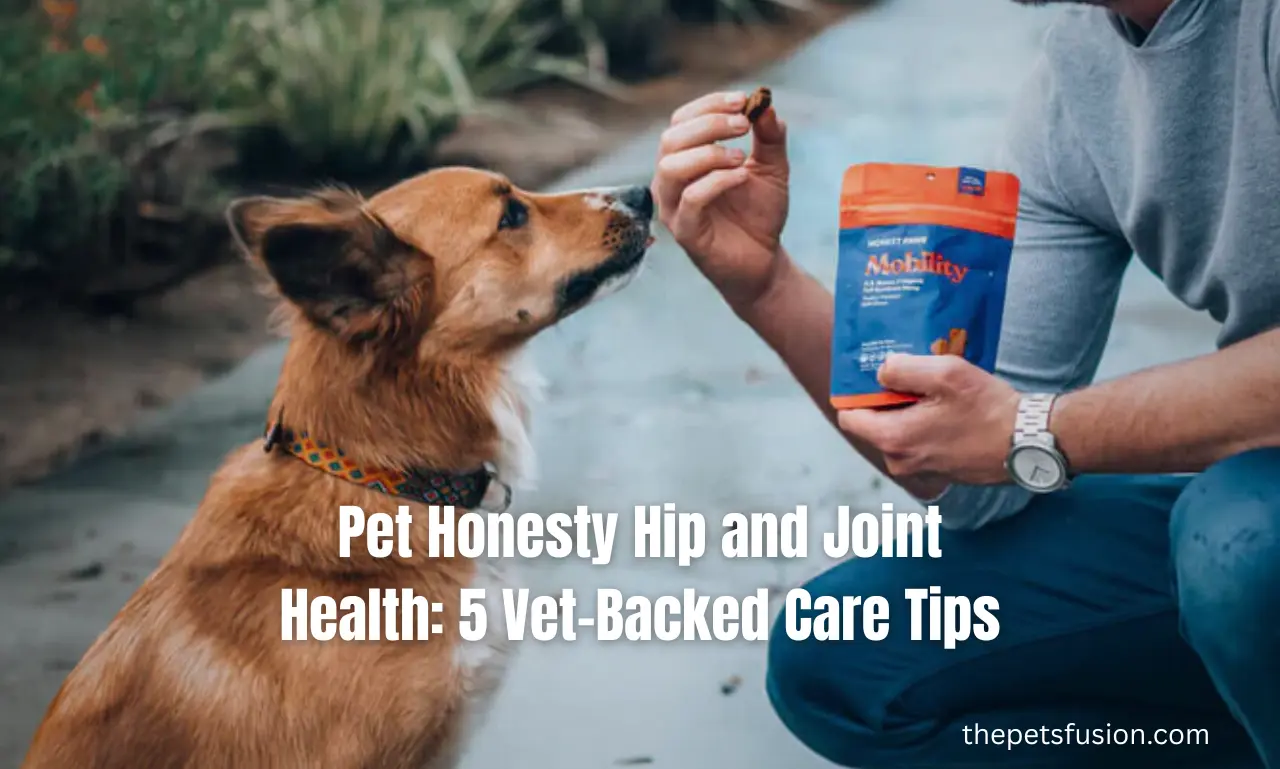If your pet is slowing down, struggling with stairs, or just not as playful as they used to be, it might be time to give their joints a little extra love. Pet honesty hip and joint health: 5 vet-backed care tips are here to help. From choosing the right pet joint supplement to understanding dog hip health and cat joint care, you’ll learn simple ways to support your pet’s movement and comfort. We’ll also cover natural joint support for pets and clear up the hype you see in pet mobility ads, so you know what helps.
Key Takeaways
Understand Anatomy & Risk Factors
Learn how hip and joint structures work, what predisposes pets to issues like hip dysplasia and arthritis, and how pet mobility aids can help improve their quality of life.
Choose Vet-Backed Supplements
Discover how pet joint supplement formulas (e.g., glucosamine, chondroitin) support cartilage repair and reduce inflammation.
Prioritize Exercise & Weight Management
Explore safe, daily routines that strengthen muscles and protect joints while keeping your pet lean.
Leverage Supportive Therapies
Hydrotherapy, physical therapy, and orthotic devices can relieve pain and enhance mobility.
Incorporate Natural Joint Support
Integrate diet tweaks, herbal remedies (turmeric, omega-3s), and environmental modifications for longer-term joint health.
1. Understanding Anatomy & Risk Factors
Hip & Joint Basics
Ball-and-Socket Joints
Dogs and cats have ball-and-socket joints (hips, shoulders) that are covered in cartilage and lubricated by synovial fluid.
Cartilage Wear
Over time or due to genetic factors, cartilage thins, leading to bone-on-bone friction, which is characteristic of osteoarthritis.
Common Conditions
Hip Dysplasia
Especially prevalent in large breeds (Labradors, German Shepherds), hip dysplasia appears when the hip socket does not entirely cover the ball joint, causing instability and pain.
Elbow Dysplasia
Often seen in medium/large dogs, leading to lameness and reduced pet mobility.
Osteoarthritis (Degenerative Joint Disease): A progressive breakdown of cartilage that afflicts up to 20% of dogs over one year old and similarly affects senior cats.
Patellar Luxation
Common in small dogs and cats, where the kneecap dislocates, leading to intermittent lameness.
Risk Factors
Breed Predisposition
Large, rapidly growing breeds, and certain purebreds harbor higher genetic risks.
Obesity
Extra weight places undue stress on joints; Overweight pets are up to five times more likely to develop arthritis.
Age
Although all age groups can be affected, risk climbs steeply after age 6 in dogs and age 10 in cats.
Injury & Overuse
Past trauma (fractures, ligament tears) accelerates wear, as do repetitive high-impact activities.
Tip: Early screening—via X-rays or gait analysis—can detect subtle changes long before your pet limps, enabling preemptive action.
2. Vet-Backed Supplements
Why Use Supplements?
While a balanced diet is critical, joint-support supplements provide targeted nutrients that:
- Promote cartilage repair
- Reduce inflammation
- Enhance synovial fluid quality
Key Ingredients
Glucosamine & Chondroitin
- Stimulate cartilage production
- Reduce degradation enzymes
MSM (Methylsulfonylmethane)
- Natural sulfur source for connective tissue health
- Anti-inflammatory properties
Omega-3 Fatty Acids (EPA & DHA)
- From fish oil or algal oil in cat formulas
- Modulate inflammatory pathways, easing joint pain
Green-lipped Mussel Extract
- Rich in glycosaminoglycans for lubrication
- Demonstrated to improve mobility in dogs
Hyaluronic Acid
- Enhances synovial fluid viscosity
- Provides shock absorption
Choosing a High-Quality Pet Joint Supplement
Third-Party Testing
Look for products certified by organizations like NASC (National Animal Supplement Council).
Guaranteed Analysis
Check concentrations—e.g., at least 1,000 mg glucosamine per dose for dogs.
Palatability
Chewables or soft chews encourage compliance; cats often prefer powder mixed into food.
Veterinarian Formulation
Lines like “Pet Honesty Hip” combine vet-formulated ratios to maximize joint health support without filler ingredients.
Pro Tip: Introduce new supplements gradually over 7-10 days to monitor tolerance and avoid gastrointestinal upset.
3. Exercise & Weight Management
The Role of Exercise
Regular, low-impact activity:
- Strengthens supporting muscles
- Enhances joint lubrication
- Prevents stiffness
Sample Routine for Dogs
- Warm-Up Walks (5–10 min): Slow pace to loosen muscles
- Moderate Cardio (20–30 min): Brisk walk or gentle jog, adjusted to breed and age
- Low-Impact Alternatives: Swimming or underwater treadmill sessions for buoyant support
- Cooldown (5 min): Slow walk and gentle stretching
Cat-Friendly Activities
- Laser Pointer Play: Stimulates short bursts of chase
- Puzzle Feeders: Encourages natural stalking and pouncing
- Cat Trees & Shelves: Promotes climbing (strengthens hindquarters)
Weight Control Strategies
- Portion Control: Measure kibble with a standardized cup; avoid “free feeding.”
- High-Protein, Low-Carb Diets: Support lean muscle mass while minimizing fat gain, especially beneficial in diabetic or arthritic pets.
- Regular Weigh-Ins: Track body condition score (BCS) monthly; A two-point reduction can yield significant joint relief.
Note: Every extra pound on a dog’s frame exerts an estimated 4 pounds of pressure on the hips and knees, so slimming down can dramatically decrease discomfort.
Don’t miss: 9 Playful Pet Lifestyle Hacks for Happier Pets in 2025
4. Supportive Therapies
Hydrotherapy
Underwater Treadmill
Precisely controls buoyancy and resistance; ideal for rebuilding muscle post-surgery or alleviating advanced arthritis.
Swimming Sessions
Encourage natural paddling; best under supervision in shallow, secure pools.
Physical Therapy & Rehabilitation
Laser Therapy
Low-level lasers penetrate tissue, reduce pain and inflammation, and accelerate healing.
Massage and passive Range-of-Motion
(PROM) improves circulation and joint flexibility. A certified canine rehabilitation therapist can teach you basic techniques.
Acupuncture
Stimulates specific points to modulate pain signals and decrease inflammation; especially effective in chronic arthritis.
Orthotic & Assistive Devices
Hip Supports & Compression Wraps
Provide warmth and stability for mild to moderate hip laxity.
Slings & Harnesses
Aid mobility for pets with severe weakness; let you assist the hindquarters during walks.
Orthopedic Beds
Cushioned with memory foam to distribute weight and relieve pressure points evenly overnight.
Insider Insight: Combining hydrotherapy with targeted strength training under the guidance of a certified rehab professional can improve mobility scores by up to 30% in six weeks.
5. Natural Joint Support
Dietary Tweaks
Antioxidant-Rich Foods
Blueberries, spinach, and turmeric (in moderation) combat oxidative stress linked to cartilage breakdown.
Bone Broth
Rich in collagen and gelatin; Homemade or commercial broths provide amino acids critical for connective tissues.
Herbal Add-Ins:
- Turmeric & Curcumin: Potent anti-inflammatory; combine with a pinch of black pepper (piperine) to enhance absorption.
- Boswellia Serrata: Extract shown to reduce joint swelling and pain in dogs.
- Yucca Schidigera: May help modulate inflammatory cytokines.
Environmental Modifications
Non-Slip Flooring
Lay down area rugs or rubber mats to prevent slips, especially on tile or hardwood.
Ramps & Pet Steps
Make sofas, beds, and cars accessible without high-impact jumping.
Temperature Control
Cold exacerbates stiffness. Provide heated pads or blankets in winter and keep rooms at a comfortable 20–22 °C (68–72 °F).
Enrichment for Joint Health
- Rotate toys to encourage varied movement patterns.
- Schedule multiple short play sessions to prevent overexertion.
- Provide soft, supportive bedding in multiple locations so your pet can nap close by after gentle activity.
Pet Honesty Hip
Discover expert-approved tips from the pet honesty Hip and joint health guide.
- Learn how to recognize early signs of joint discomfort in pets
- Get advice on safe, effective joint care routines for dogs and cats
- Explore the benefits of natural supplements and anti-inflammatory diets
- Understand the role of pet joint supplements in everyday wellness
- Prevent joint issues with simple lifestyle changes and gentle exercises
- Ideal for aging pets or those recovering from injury
- Keep your pet active, playful, and pain-free for years to come
Joint Health Supplement
Find the best joint health supplement for Your pet’s needs
- Learn what makes a quality joint health supplement for pets
- Vet-backed advice for managing stiffness, arthritis, or reduced mobility
- Explore natural options like glucosamine, chondroitin, and turmeric
- Understand how proper nutrition supports joint health long-term
- Combine supplements with exercise and regular checkups for the best results
- Get tips for both dog hip health and cat joint care
- Prevent future mobility issues with proactive daily care
- Make confident, informed choices to support your pet’s comfort and energy
The Bottom Line
Pet honesty hip and joint health: 5 vet-backed care tips give you everything you need to protect your pet’s joints before problems arise. Whether you’re considering a pet joint supplement or looking for natural ways to improve dog hip health and cat joint care, minor changes today can bring long-term benefits. From natural joint support for pets like omega-3s and turmeric to proven therapies like hydrotherapy, this guide empowers you with trusted, vet-approved strategies. Tired of sorting through pet mobility ads that overpromise and underdeliver? Now you know what truly works. With the right joint health supplement and daily care, your furry companion can move freely and stay playful longer. Trust pet honesty hip advice to keep them healthy, happy, and pain-free at all times.
Don’t miss: 7 Affordable Pet Grooming Products to Extend Their Life
Frequently Asked Questions
1. What is Pet Honesty Hip, and how does it support joint health?
Pet honesty hip is a veterinarian-formulated joint health supplement made to support pets experiencing stiffness, discomfort, or mobility decline. It includes ingredients like glucosamine, MSM, and omega-3s that help reduce inflammation and promote joint lubrication—perfect for aging dogs or cats needing extra support.
2. Do I need a pet joint supplement for a young, active pet?
Yes! A high-quality pet joint supplement isn’t just for older pets—it helps active, growing, or high-impact breeds maintain healthy joints and delay future issues. Starting early provides natural joint support for pets, particularly in breeds prone to hip dysplasia or arthritis.
3. What’s the best way to improve a dog’s hip health at home?
Dog hip health thrives on targeted supplements, low-impact exercise (like swimming), and a lean diet. Using ramps, orthopedic beds, and joint-friendly activities like leash walks also reduces wear on the hips and knees.
4. Is cat joint care essential? My cat seems fine.
Absolutely. Cats are experts at hiding pain. Cat joint care has become crucial as they age, especially in the past 10 years. Look for signs like reluctance to jump, stiffness after naps, or missed litter box visits—and consider adding a joint health supplement to their routine.
5. How does the joint health supplement I’m using work?
Look for results like more effortless movement, improved playfulness, and fewer signs of stiffness. Also, choose joint health supplements with vet-backed ingredients like chondroitin, green-lipped mussel, and hyaluronic acid. Products with Pet Honesty Hip formulas are a great start.
6. What is the difference between natural joint support and prescription treatments?
Natural joint support for pets (like omega-3s, turmeric, and glucosamine) helps manage inflammation and nourish joints without medication. Prescription treatments can be more potent but may carry side effects. Many vets recommend starting with natural supplements to delay or reduce the need for meds.
7. Are pet mobility advertisements trustworthy? What should I look out for?
Some pet mobility ads promise fast results but lack evidence. Always read the ingredient list, look for clinical studies, and choose products with third-party testing. Stick to vet-recommended brands—like those behind Pet Honesty Hip and Joint Health products—for proven effectiveness.
8. Can I combine exercise with supplements for better results?
Yes! Pairing supplements with consistent, low-impact exercise (like short walks or swimming) enhances outcomes. This combo improves flexibility, reduces stiffness, and strengthens supporting muscles, especially beneficial for dog hip health and senior cat joint care.






